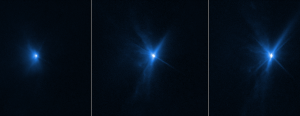NASA Hits Big with Asteroid Defense
DART, a 1,260-pound, boxy device, represents not only “an unprecedented success” for planetary defense but also “a mission of unity with a real benefit for all humanity,” said NASA Administrator Bill Nelson.
DART’s target, Dimorphos, is a pyramid-size moonlet 530 feet in diameter that orbits a larger asteroid called Didymos. Neither object poses a threat to Earth.
The spacecraft’s sole instrument, the Didymos Reconnaissance and Asteroid Camera for Optical navigation (DRACO), together with a sophisticated guidance, navigation, and control system, enabled DART to identify and distinguish between the two asteroids and then target the smaller one.
Investigators will now observe Dimorphos using ground-based telescopes to confirm that DART’s impact altered the asteroid’s orbit around Didymos. Researchers expect the impact to shorten Dimorphos’ orbit by about 1 percent, or roughly 10 minutes.
See images from DART’s close encounter with the asteroid taken by its CubeSat companion, Light Italian CubeSat for Imaging of Asteroids (LICIACube), provided by the Italian Space Agency, at https://go.nasa.gov/3Rer1NW
Filed under: Special Features
Tags: CubeSat, Johns Hopkins Applied Physics Laboratory, kinetic impact, NASA Double Asteroid Redirection Test, planetary defense, space exploration, spacecraft









